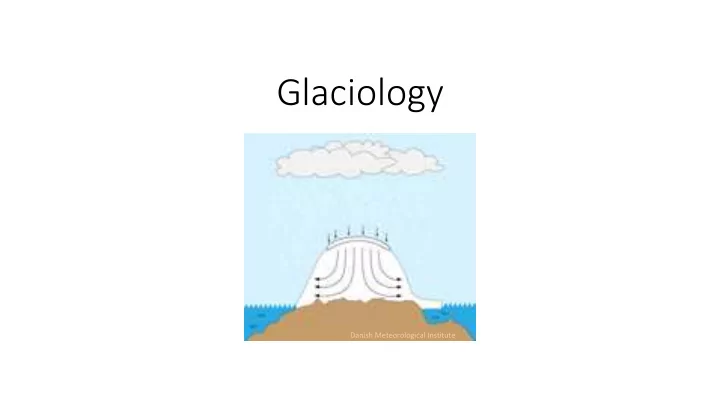

Glaciology Danish Meteorological Institute
Glaciers
NASA Ice Sheets
Modern glaciology • Satellite remote sensing and the first large scale ice sheet models came online in the early 1990s • Three main satellite data products: ice velocity, ice surface height, and ice mass. Rignot et al 2011, Science
Geophysical observations: satellite remote sensing Gravity Altimetry Radar Multispectral imagery “Many of the measurements still routinely taken differ only in the speed and accuracy with which they can now be made.” (Launch Date: September (Clarke, 1987) 15, 2018 5:46am PDT)
Geophysical observations: mountain glaciers Randolph Glacier Inventory
Geophysical observations: new datasets right now • REMA = “Reference elevation model of Antarctica” • Based on stereo photogrammetry plus altimetry. • Released on Wednesday. • 2 m resolution of the entire ice sheet. • 10^11 data points. That’s big even for tech companies.
Geophysical observations: data rich and data poor • We have good data availability in several important quantities (ice velocity, ice surface height). Fully appreciating these datasets will be a major growth area in glaciology for at least a decade. • Yet we are data poor in other areas (bed topography, meteorological measurements, geothermal heat flux, long time series of anything)
Geophysical observations: air borne and ground-based radar Operation Ice Bridge
Time scales of glacier change: ice age cycles Greenland Antarctica (Vostok, figure from Wikipedia) Operation Ice Bridge
Fast time scales of glacier change: ice shelf breakup • A “traditional” timescale associated with ice sheet change is h/a (thickness/accumulation rate), which for Antarctica is about 10 4 or 10 6 years. • In stark contrast, the Larsen B ice ice shelf completely collapsed in a period of about 8 weeks (and maybe much faster, the observations are coarse in time). NASA EarthObservatory NASA EarthObservatory
Fast time scales of glacier change: grounding line dynamics The grounding line instability has been a central focus of ice sheet glaciology for the last 40 years. Recent work has emphasized stabilizing mechanisms: • Marginal shear in ice streams • Ice shelf buttressing • Gravitational self attraction of ocean water • Glacial isostatic adjustment Controversially, we could ask, is the grounding line instability relevant to real ice sheets? (Credit: Valentina R. Barletta, CC-BY)
The ice sheet mesoscale: ice streams and ice shelves (and more) JPL SwissEduc NASA • What enables fast flow of ice around the margins of large ice sheets? • We will expore a simple model where basal water pressure and the bed substrate are essential.
The ice sheet mesoscale: ice streams and ice shelves (and more) JPL SwissEduc Sea Level Rise Uncertainty AR5 40 Fast ice dynamics 30 Millimeters 20 Surface mass per century balance 10 Other 0 Thermal Glaciers Greenland Antarctica Land water NASA expansion storage • What enables fast flow of ice around the margins of large ice sheets? • We will expore a simple model where basal water pressure and the bed substrate are essential.
Small-scale physics: the effects of interfacial chemistry SwissEduc • The interfacial physical chemistry of ice has profound implications for glacier basal sliding, sediment entrainment, and the alteration of ice core records. • Ice contained in a matrix has a higher melting point and a small Rempel 2008 free standing ice particle has a depressed melting point; both are due to interfacial tension.
The ice—atmosphere interface: mass and energy budgets An extreme melt event in Greenland in 2012 has been interpreted as a potential window into future conditions. What caused this melting? Low level clouds have been implicated. Optically thick enough to enhance the • downgoing infrared flux to the ice surface, yet Optically thin enough to allow shortwave • radiation to reach the surface
The ice—atmosphere interface: mass and energy budgets • Katabatic winds are down- slope winds that are driven by advection through a background lapse rate and the resulting buoyant acceleration. • In the Antarctic interior, katabatic winds describe the majority of the annual wind field. • Blue ice zones result in areas with extreme wind scour. (Image about 200km wide)
Insights into past climates • Borehole temperatures GRIP Temperature Profile 1995 Dye 3 Temperature Profile 1983 0 0 directly constrain past 20 0 D B LIA LIA surface temperatures, here showing (insets) the Little 500 500 Ice Age (LIA) and the CO CO 1000 1000 Holocene Climate Optimum Depth (m) Depth (m) (CO). 1000 1000 -31.8 -31.6 -31.4 -20 -18 • A simple model of these 2000 data requires a thermal 1500 evolution model based on heat conduction, A C 2000 advection, and climate 3000 -30 -20 -10 -20 -18 -16 -14 forcing. Temperature ( ° C) Temperature ( ° C)
Insights into past climates • A lake drainage event is thought to have caused a brief return to glacial conditions at 8.2ka. • We will explore a basic model where turbulent melting of the conduit walls balances the tendancy for subglacial walls to creep closed.
Mountain Glaciers Contemporary changes • Mountain glaciers are the smallest reservoir and are observed to have the greatest fractional mass loss. • Antarctica is by far the largest reservoir of ice on Earth, as is observed to have the smallest fractional change. • What is the role of internal variability in Antarctic Ice Sheet mass loss? What changes are attributable to human activity? AR5 AR5 IMBIE Report, 2018
Course Outline 1. Synoptic scale glaciology 2. Mesoscale glaciology • The glacier-atmosphere interface • The glacier-bed interface • The glacier-ocean interface 3. Ice and climate Bi weekly problem sets + final project Office hours doodle poll + appts
Constraints on LGM climate e from gl glacial geomorpho phology gy and a a min inim imal al ic ice e model el
Constraints on LGM climate from glacial geomorphic features and a minimal ice model
Constraints on LGM climate from glacial geomorphic features and a minimal ice model
Recommend
More recommend